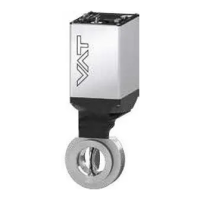Installation, Operating & Maintenance Instructions
Series 615 DN 40 (I.D. 1½”), DeviceNet
VAT Vakuumventile AG, CH-9469 Haag, Switzerland
Tel +41 81 771 61 61 Fax +41 81 771 48 30 CH@vatvalve.com www.vatvalve.com
Gas flow calculation for LEARN:
Do not apply a different gas flow for learn than determined below. Otherwise pressure control
performance may be insufficient.
Note: Required pressure / flow regime must be known to calculate the most suitable learn gas flow for a specific
application.
2. At first it is necessary to find out about the required control range respectively its conductance values. Each working
point (pressure / flow) must be calculated with one following formulas.
Choose the applicable formula depending on units you are familiar with.
C
WP
required conductance of working point [l/s]
q
WP
gas flow of working point [Pa m
3
/s]
p
WP
pressure of working point [Pa]
C
WP
required conductance of working point [l/s]
q
WP
gas flow of working point [mbar l/s]
p
WP
pressure of working point [mbar]
C
WP
required conductance of working point [l/s]
q
WP
gas flow of working point [sccm]
p
WP
pressure of working point [Torr]
3. Out of these calculated conductance values choose the lowest.
C
R
= min(C
WP1,
C
WP2, . . . ,
C
WPn
)
C
R
required lower conductance [l/s]
C
WPx
required conductance of working points [l/s]
Note: To make sure that the valve is capable to control the most extreme working point verify that
C
R
≥ C
min
of the valve (refer to «Technical data»).
4. Calculate gas flow for learn with Pmax <1mbar. Choose the applicable formula depending on units you are familiar
with. (molecular)
q
L
gas flow for learn [Pa m
3
/s]
p
max
max. pressure to control [Pa]
C
R
required lower conductance [l/s]
q
L
gas flow for learn [mbar l/s]
p
max
max. pressure to control [mbar]
C
R
required lower conductance [l/s]
q
L
gas flow for learn [sccm]
p
max
max. pressure to control [Torr]
C
R
required lower conductance [l/s]

